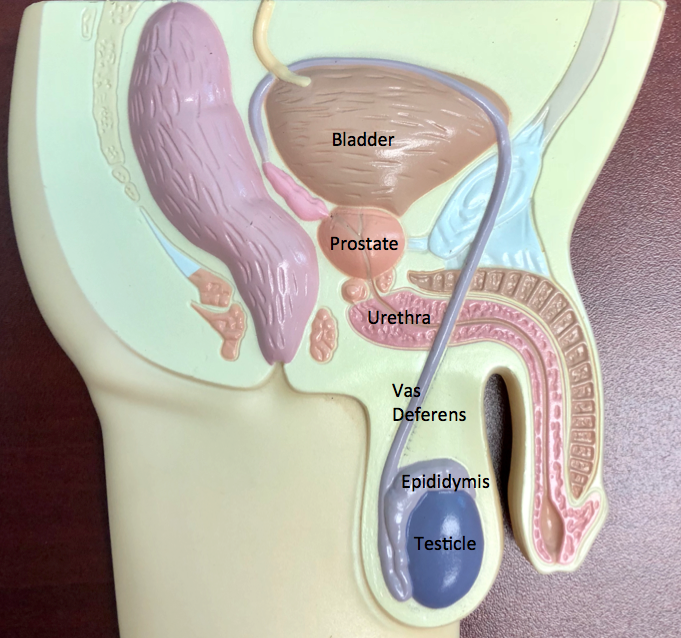Hematospermia
Hematospermia is the word used to describe the presence of blood in the semen. Blood in the semen is actually a fairly common condition. It is almost always a benign condition that is not a sign of anything which would potentially pose a threat to a man’s health.
How is the reproductive system put together?
The reproductive system begins with the testicles that are located in the scrotum. The testicles make sperm that is then transported into a collection of tubes in back of the testicle called the epididymis. From there sperm is transported through a tube called the vas deferens (this is what is divided in a vasectomy), to reach the seminal vesicles and prostate. The seminal vesicle and prostate are glands that are part of the reproductive system which make some of the fluid that comes out in the semen. This is the white fluid that comes out at the time of ejaculation.

Where does blood in the semen come from?
When blood is present in the semen, it arises from either the seminal vesicle or prostate.
The most common cause for blood in the semen is the rupture of a small blood vessel in the seminal vesicle or prostate during erection and ejaculation. Blood vessels can break open in the seminal vesicle and prostate just the same as a blood vessel can break open in the nose after sneezing and cause a nose bleed.
What is done to check a man with blood in his semen?
When hematospermia is present, the physician examines the scrotal area first to make sure there are not any abnormalities present within the testicle, epididymis or along the vas deferens.
The seminal vesicle and prostate are also checked with a digital rectal exam. The physician inserts a gloved finger into the rectal area to feel the surface of the prostate to determine if there are any areas of irregularity.
The urine is checked to make sure that blood is not present in the urine. If blood is present in the urine this is a separate problem that requires further evaluation.
In men over the age of 40, a PSA may be checked to make sure that prostate cancer is not present.
How is it treated?
Provided the above examinations show normal findings, nothing further needs to be done.
Hematospermia usually resolves on its own over time.
In some men, it may be a recurrent problem and develop on an intermittent basis.
Rarely, it may be a steady ongoing problem. In these circumstances, a transrectal ultrasound may be done to evaluate the seminal vesicle and prostate. Prostate ultrasound is done by inserting a small probe into the rectum that takes sonographic pictures of the prostate and seminal vesicles. This is a simple office procedure that is similar to a digital rectal exam. Ultrasound is carried out to make sure there are not abnormalities such as cysts or calcifications in the seminal vesicle or prostate.
If there is a persistent hematospermia, then treatment with Proscar (finasteride) for several months may be recommended. Proscar is a drug that was designed to reduce the size of the prostate in men with BPH (benign prostatic hyperplasia), which is the normal enlargement of the prostate that occurs in all men starting at the age of 40. Although Proscar has only limited usefulness in men with BPH it has been very effective for treating hematospermia. Men using Proscar need to make sure that their female partners do not become pregnant.
Take Home Message
Overall, hematospermia is a benign condition. With the above office examination, the physician can determine if there are any significant problems present. If the examination is okay, then typically nothing further needs to be done.
Men can feel reassured that this is not a symptom of something which would pose a threat to their health.
Contact us to request an appointment or ask a question. We're here for you.




